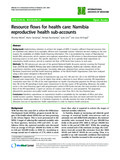| dc.description.abstract | Implementing initiatives to achieve the targets of MDG 5 requires sufficient financial resources that are mobilized and utilized in an equitable, efficient and sustainable manner. Informed decision making to this end requires the availability of reliable health financing information. This is accomplished by means of Reproductive Health (RH) sub-account, which captures and organizes expenditure on RH services in two-dimensional tables from financing sources to end users. The specific objectives of this study are: (i) to quantify total expenditure on reproductive health services; and (ii) to examine the flow of RH funds from sources to end users. The RH sub-account was part of the general National Health Accounts exercise covering the Financial Years 2007/08 and 2008/09. Primary data were collected from employers, medical aid schemes, donors and government ministries using questionnaire. Secondary data were obtained from various documents of the Namibian Government and the health financing database of the World Health Organization. Data were analyzed
using a data screen designed in Microsoft Excel. RH expenditure per woman of reproductive age was US$ 148 and US$ 126 in the 2007/08 and 2008/09 financial years respectively. This is by far higher than what is observed in most African countries. RH expenditure constituted more than 10-12% of the total expenditure on health. Out-of-pocket payment for RH was minimal (less than 4% of the RH spending in both years). Government is the key source of RH spending. Moreover, the public sector is the main financing agent with programmatic control of RH funds and also the main provider of services.
Most of the RH expenditure is spent on services of curative care (both in- and out-patient). The proportion
allocated for preventive and public health services was not more than 5% in the two financial years. Namibia’s expenditure on reproductive health is remarkable by the standards of Africa and other middle-income countries. However, an increasing maternal mortality ratio does not bode well with the level of reproductive health expenditure. It is therefore important to critically examine the state of efficiency in the allocation and use of reproductive health expenditures in order to improve health outcomes. | en_US |

